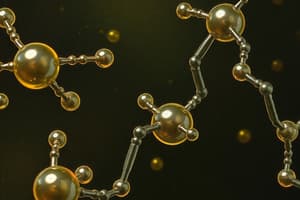Podcast
Questions and Answers
Why do mammals that live in the Arctic Ocean have so much blubber?
Why do mammals that live in the Arctic Ocean have so much blubber?
Lipids in blubber insulate the animals from cold water.
At which of these locations is a dietitian least likely to work?
At which of these locations is a dietitian least likely to work?
- Fitness Center
- Theater (correct)
- School
- Hospital
What is cellulose?
What is cellulose?
Carbohydrate
Glycogen is a carbohydrate and insulin is a protein.
Glycogen is a carbohydrate and insulin is a protein.
Which statement best describes the components of nucleic acids?
Which statement best describes the components of nucleic acids?
How does a dietitian help a patient?
How does a dietitian help a patient?
Which macromolecule provides a person with most of the energy needed for daily activities?
Which macromolecule provides a person with most of the energy needed for daily activities?
Which macromolecule forms a double layer as the primary structure of cell membranes?
Which macromolecule forms a double layer as the primary structure of cell membranes?
Which molecule consists of long chains of red and black colored balls?
Which molecule consists of long chains of red and black colored balls?
Which statement correctly compares nucleic acids and carbohydrates?
Which statement correctly compares nucleic acids and carbohydrates?
Flashcards are hidden until you start studying
Study Notes
Macromolecules Overview
- Blubber in Arctic mammals acts as an insulator against cold water due to high lipid content.
- Dieticians do not typically work in theaters, which is important for recognizing appropriate work environments.
Carbohydrates
- Cellulose is a carbohydrate crucial for plant cell wall structure, providing rigidity.
- Glycogen, another carbohydrate, serves as an energy-storage molecule in humans regulated by insulin, which is a protein composed of amino acids.
Nucleic Acids
- Nucleic acids are composed of nitrogenous bases, sugars, and phosphates, distinguishing them from other macromolecules.
Role of Dieticians
- Dieticians play a significant role in helping patients by ensuring they receive the proper amount of nutrients, rather than treating vision problems or genetic disorders.
Energy Sources
- Carbohydrates are the primary macromolecule providing energy for daily activities, crucial for metabolism and physical activities.
Cell Membrane Structure
- Phospholipids are essential in forming the double layer structure of cell membranes, a fundamental aspect of cellular organization.
Macromolecule Models
- Long chains of hydrogen (red) and carbon (black) colored balls represent lipids, indicative of their fundamental composition.
Comparison of Macromolecules
- Nucleic acids and carbohydrates both contain carbon, but only nucleic acids include phosphorus, important for their structure and function in genetic information storage.
Studying That Suits You
Use AI to generate personalized quizzes and flashcards to suit your learning preferences.




